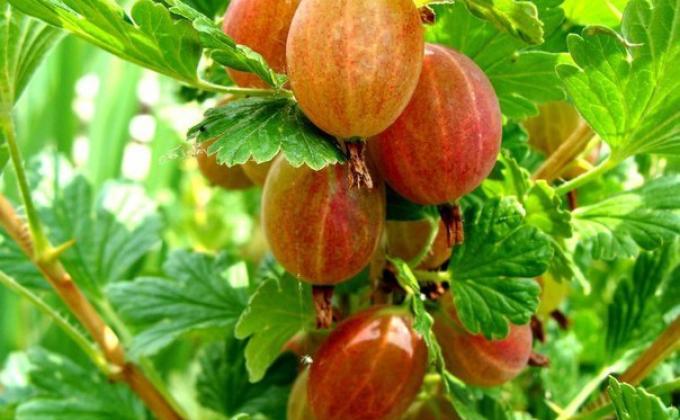The best varieties of gooseberries are obtained from crossing European large-fruited varieties and American species. The goals and objectives of breeders primarily included the breeding of gooseberry varieties resistant to powdery mildew and with fewer thorns. This article provides brief characteristics of some varieties.
The Aristocrat gooseberry variety is derived from crossing Prune and Sirius varieties. A bush with an average degree of branching, medium-spreading, has an average density of shoots and strong growth. Shoots are straight, thick, green, the number of thorns is small. The berries are quite large up to 6 g. The color of the berries is dark red, fully ripe berries are almost black. The taste is sweet and sour. The variety is resistant to powdery mildew, hardy.
The Harlequin gooseberry variety was obtained by crossing the African and Chelyabinsk green varieties. The bush has an average spreading, height and density. There are few thorns. The berries are dark cherry-colored, sweet and sour, weighing from 3 to 5 grams. The variety is high-yielding, hardy, resistant to powdery mildew.
The White Nights variety was obtained from crossing the varieties Mysovsky 17 and Hansa. The bush is compact, medium-sized, with a large harvest it becomes sprawling. There are a lot of thorns. Sweet dessert-flavored berries, ranging in size from 1.5 to 4.3 gr. The variety is resistant to powdery mildew, hardy, early ripening, yielding up to 6 kg of berries from a bush and more.
The Beryl gooseberry variety is obtained from crossing the Nugget and Malachite varieties. It is recommended to grow it in Western Siberia. The bush is dense, medium-spreading, of medium height, the thorns are located in the lower part of the shoots. The berries are large, from 3 to 9 g and more, light green, sweet and sour, dessert taste. The variety is high-yielding (up to 10 kg of berries from a bush), hardy.
The Bitsevsky variety was obtained from crossing the Date and No. 595-3-3 varieties. The bush is slightly spreading, medium-sized, with a small number of thorns. The berries are sweet and sour, dark red, up to 4.7 g in size. After ripening, the berries do not crumble for a long time.
The Vladil (Commander) variety was obtained from crossing the Afrikaner and Chelyabinsk Green varieties. The bush is dense, compact, strong-growing. Not all shoots have thorns. The berries are almost black, sweet and sour, ranging in size from 2.5 to 4.5 g. The variety is hardy, resistant to powdery mildew, yielding. The yield from one bush reaches 7.5 kg.
Strawberry variety is obtained from crossing Souvenir and African varieties. The bush is compact, medium-sized, with a large number of thorns. Medium-sized berries, from 2.7 to 5.5 g, dessert, have a strawberry flavor. The color of the berries is light green, there are dark red spots on the sunny side. The variety is resistant to powdery mildew, hardy, yielding.
The Kazachok variety was obtained from the Shipless-3 variety by free pollination. The bush is medium-sized, spreading, medium-sized with thorns. Medium-sized berries (3-4gr), almost black in color. The variety is resistant to powdery mildew, very hardy, tolerates drought well, medium-yielding, gives up to 4 kg per bush and more.
The Kolobok variety was obtained from crossing the Smena and Pink 2 varieties. The bush is dense, medium-spreading, strong-growing, well-branched. The berries are sweet and sour, dark red taste, weighing up to 8g. There are not very many thorns. Ripe berries keep well on bushes, without crumbling, shoots easily take root.
The Candy variety is obtained from a complex crossing of the Smena variety and pollen of the Varshavsky, Date, Brazilian, Iskra varieties. The bush is dense, erect, medium-sized, the upper part of the shoots without thorns. The berries are medium and large, from 3 to 6 gr. The color of the fragrant berries is pink, the taste is sweet and sour. The variety is quite resistant to powdery mildew, hardy, yielding, up to 6.2 kg of berries per bush.
The Cooperator variety was obtained from crossing the Chelyabinsk Green and Smena varieties. The bush is dense, medium-sized, slightly spreading, there are thorns mainly at the base of the shoots. The berries are dark cherry, sweet and sour, weighing up to 8g. The variety is resistant to powdery mildew, hardy, yielding, up to 6.9 kg can be harvested from one bush.
The Krasnoslavyansky variety was obtained from crossing the Oregon and Avenarius varieties. The bush is slightly spreading, medium-sized, with a large number of thorns. Dark cherry berries have a sweet, dessert taste and weigh up to 6g. The harvest of berries from the bush reaches 6kg. The winter hardiness of the variety is average and the same average resistance to powdery mildew.
The Red large variety was obtained from hybrid seedlings back in 1939. It is recommended for cultivation in Western Siberia. The bush is sprawling, stunted, the thorns on the branches often fall off after 3 - 4 years. The berries have a sweet and sour taste, dark red, sometimes bottle-shaped. The variety is resistant to powdery mildew, hardy, yielding. The yield of berries ranges from 1.5 to 6.5 kg per bush.
The Kubanets variety is obtained from free pollination of the Green Bottle variety. The bush is not dense, slightly tall, slightly spreading, has thorns. The berries are light green, sweet and sour, weighing up to 8g. The variety is productive, drought-resistant, winter hardiness and resistance to powdery mildew are average.
The Pet variety is obtained from the Chelyabinsk Green variety by free pollination. The bush is medium-thickened, medium-spreading, medium-tall, with thorns. The berries are green-yellow, sweet and sour, transportable, weighing up to 4.3 g. The average yield is 2.5 kg per bush. The variety is high-yielding, drought-resistant, winter-hardy, resistant to powdery mildew.
The best varieties of gooseberries are therefore the best because they have already been tested many times and therefore it is more accurately possible to plan the size of the harvest that is expected to be obtained.




Светлана Природная